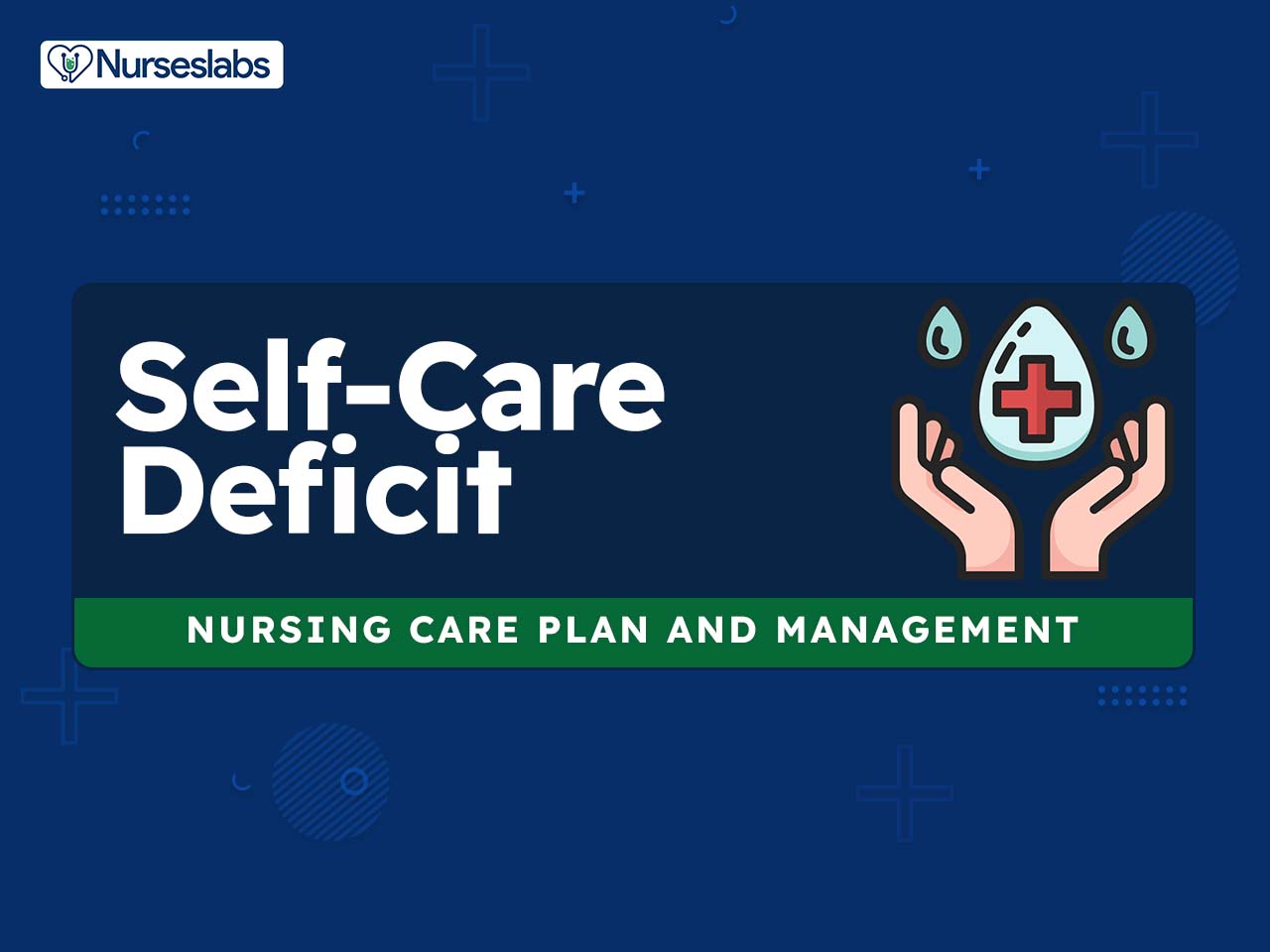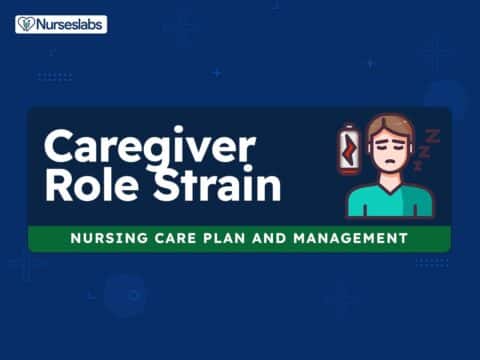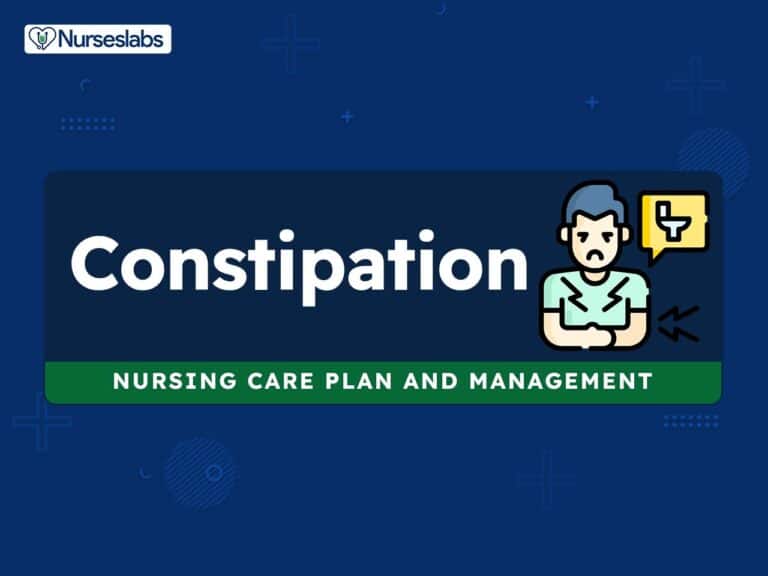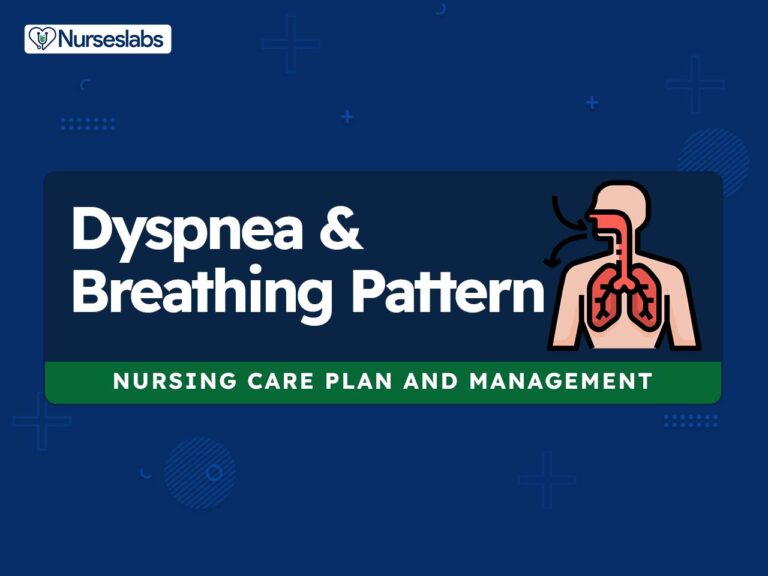Access this comprehensive nursing care plan and nursing diagnosis guide for patients with self-care deficit. In this guide, we’ll cover the nursing assessment, interventions, goals, and diagnosis related to care of patients with self-care deficit.
What is Self-Care?
According to Dorothea Orem’s Self-Care Deficit theory, self-care is a learned and intentional behavior aimed to maintain the life, health, and well-being of the individual. If performed effectively, it contributes to structural integrity, human functioning, and development. There are three types of self-care requisites according to Orem: development self-care requisites, health deviation self-care requisites, and universal self-care requisites. Commonly, universal self-care requisites are called activities of daily living (ADLs). A deficit in universal self-care requisites leads to changes in everyday life such as bathing, dressing, toileting, and positioning (Queiros et al., 2021).
What are Activities of Daily Living?
Activities of daily living (ADLs) encompass the routine tasks an individual regularly performs, such as eating, bathing, dressing, grooming, working, homemaking, and leisure activities. These self-care tasks are essential actions that individuals autonomously undertake to preserve and improve their overall well-being. However, there are instances when individuals experience a deficit in self-care due to various factors. This deficit can arise from temporary limitations, such as post-surgical recovery, or from a gradual decline that hampers a person’s capacity or inclination to attend to their self-care needs. Additionally, individuals grappling with depression may lack the motivation or energy to engage in self-care activities, further exacerbating the deficit.
Instrumental activities of daily living (IADLs) include complex skills that the client needs for independent living, such as meal preparation, grocery shopping, household management, finances, and transportation. These activities require a higher level of cognitive and organizational skills compared to basic ADLs. IADLs impact the client’s ability to live independently and maintain a good quality of life. If older adults or clients with disabilities can perform IADLs efficiently, they would be able to maintain their autonomy and remain in their own homes for longer periods, delaying the need for assisted living or long-term care.
It is important for nurses to recognize and address these deficits to support individuals in regaining their independence and promoting their physical and mental health. By implementing appropriate interventions and providing necessary support, nurses can empower individuals to resume and maintain their self-care and activities of daily living.
Nursing Care Plans and Management
The management of self-care and activities of daily living (ADLs) involves a collaborative effort between healthcare professionals, clients, and caregivers. Nurses play a central role in guiding clients toward optimal self-care, teaching essential skills, and providing necessary assistance while encouraging independence. The inclusion of family members and caregivers in the care planning process enhances the client’s support system and ensures continuity of care beyond healthcare settings.
Nursing Problem Priorities
The following are the nursing priorities for clients needing assistance with self-care needs and have ADL limitations:
- Limited physical mobility. The inability to move freely can affect a client’s ability to perform ADLs and self-care tasks. Prioritizing interventions to improve mobility and providing assistive devices is crucial.
- Self-care deficits. Clients who struggle with self-care activities require focused attention. Nursing interventions may include teaching adaptive techniques, providing necessary aids, or addressing cognitive or physical barriers to self-care.
- Psychosocial concerns. A client with self-care and ADL limitation may have issues with coping and decreased self-esteem. Anxiety and depression can also impact a client’s motivation and ability to engage in self-care and ADLs. recognizing signs of psychosocial problems allows the prompt intervention of the nurse.
Nursing Assessment
Assessment is crucial in identifying self-care deficits and potential nursing care episodes. Through comprehensive evaluation of the client’s health, function, environment, and support systems, nurses can develop tailored care plans, prevent complications, and promote healing. Collaborative discussions and regular reassessment support a holistic approach to self-care.
Assess for the following subjective and objective data:
- Decreased or lack of motivation in performing self-care or ADLs
- Weakness or fatigue
- Pain or discomfort
- Perceptual or cognitive impairment
- Inability to perceive a body part
- Neuromuscular or musculoskeletal impairment
- Restrictions that are medically indicated (complete bedrest)
- Therapeutic procedures limiting mobility (cast, IV therapy)
- Severe anxiety or depression
- Poor personal hygiene
- Forgetfulness; misuse or misidentification of objects
Nursing Diagnosis
After thorough assessment, nursing diagnoses are formulated to address the challenges of self-care deficit, guided by the nurse’s clinical judgment and understanding of the patient’s unique condition. While nursing diagnoses help organize care, their use may vary across clinical settings. Ultimately, the nurse’s expertise and judgment shape the care plan to prioritize each patient’s needs. Here are examples of nursing diagnoses that may be useful for common concerns associated with self-care deficit:
- Self-Care Deficit: Bathing/Hygiene related to decreased strength and limited range of motion as evidenced by inability to reach or clean body parts and body odor.
- Self-Care Deficit: Dressing/Grooming related to impaired coordination and decreased fine motor skills as evidenced by difficulty in buttoning clothing, disheveled appearance, and expressed frustration with dressing tasks.
- Self-Care Deficit: Feeding related to fatigue and poor hand-eye coordination as evidenced by inability to bring food to the mouth independently, spilling food, and decreased intake during meals.
- Self-Care Deficit: Toileting related to weakness and lack of mobility as evidenced by inability to transfer to the toilet independently, needing assistance with clothing management, and expressed discomfort due to delayed toileting.
- Self-Care Deficit: Bathing/Hygiene related to cognitive impairment as evidenced by difficulty following hygiene routines, poor grooming, and repeated need for verbal cues to complete tasks.
- Self-Care Deficit: Feeding related to decreased energy and limited upper body strength as evidenced by prolonged meal times, use of adaptive utensils, and reduced food intake due to fatigue.
Nursing Goals
Goals and expected outcomes may include:
- The client will demonstrate an improvement in performing activities of daily living (ADLs), as evidenced by independently completing self-care tasks such as bathing, dressing, and grooming without assistance within the appropriate range of time.
- The client will verbalize understanding of self-care management techniques and demonstrate the ability to implement them effectively, as evidenced by correctly following the prescribed medication regimen, dietary restrictions, and therapeutic exercises within the appropriate range of time.
- The client will actively participate in self-care education and training sessions, as evidenced by attending and engaging in educational sessions on self-care techniques, asking relevant questions, and actively seeking resources and information to enhance their self-care abilities within the appropriate range of time.
Nursing Interventions and Actions
Nursing interventions for self-care deficit include assessing the client’s current abilities, setting realistic goals, providing education and training, developing personalized care plans, supporting and monitoring the client’s progress, involving family or caregivers, collaborating with other healthcare professionals, evaluating effectiveness, and offering emotional support. Therapeutic nursing interventions and actions for these clients include:
1. Client Assessment
The nurse must observe and assess the client’s ability to perform ADLs to determine the level of independence in self-care and the need for nursing interventions. Additionally, identifying the cause of these limitations may help the nurse plan the appropriate intervention for every client’s need.
1.1. Assessment of functional ability
Assess the client’s strength to accomplish activities of daily living (ADLs) efficiently and cautiously on a daily basis using a proper assessment tool, such as the Functional Independence Measures (FIM).
The client may only need help with some self-care measures. FIM measures 18 self-care items related to eating, bathing, grooming, dressing, toileting, bladder and bowel management, transfer, ambulation, and stair climbing. Scoring is based on a seven-point scale, with items used to assess the client’s level of independence. The Alph FIM, a short version of the FIM, is used frequently within 72 hours of admission in acute care settings to measure functional independence and the amount of assistance the client needs to perform ADLs.
Consider the client’s need for assistive devices.
Assistive devices improve confidence in the performance of ADLs. If the client has difficulty performing an ADL, ad adaptive or assistive device may be useful. These devices may be obtained commercially or can be constructed by the nurse, occupational therapist, client, or family.
Verify the need for home health care after discharge.
Shortened hospital stays have resulted in clients being more debilitated on discharge and therefore requiring more assistance at home. Occupational therapists have access to a wide range of self-help devices. An important goal of rehabilitation is to assist the client to return to the home environment after learning to manage the disability. The plan for discharge is created the moment the client is admitted, and it is finished with the client’s functional potential as the priority.
Determine the client’s level of independence.
Note the client’s degree of independence by observing the client performing specific activities, such as eating or dressing. Document the time it was taken, the client’s mobility, coordination, and endurance; and the amount of assistance required. The Barthel Index may be used to measure the client’s level of independence in ADLs, continence, toileting, transfers, and ambulation.
Assess culture and beliefs that affect the degree of self-care.
Pre-existing cultural norms may influence the degree of self-care the client is willing to consider. Cultural and ethnic beliefs about hygiene can vary among individuals and families. The nurse must recognize these beliefs, work through any issues with the client and family, and communicate pertinent findings to the healthcare team.
Assess the client’s gait and alignment.
Assessment of alignment includes an inspection of the client while the client stands to identify variations in the client’s posture and learning needs to maintain a good posture. The client’s gait is assessed to determine the client’s mobility and risk for injury. Assess gait as the client walks into the room or walks a distance of ten feet down the hallway.
Determine any factors that hinder the client’s capabilities and any limitations for movement.
The nurse needs to obtain data that may indicate hindrances or restrictions to the client’s movement and the need for assistance. Observe how the client’s illness may affect the ability to move and if the client’s condition contraindicates any exertion, position, or movement. Assess if there are mechanical barriers to movement such as intravenous lines, a cast, or drainages tubings.
Monitor the client’s vital signs closely.
By determining an appropriate level of activity for the client, the nurse can predict whether the client has the strength and endurance to participate in activities that require similar expenditures in energy. The most useful measures in predicting this are the client’s vital signs, which must be obtained before the activity, during the activity, immediately after the activity stops, and three minutes after the activity has stopped and the client has rested.
1.2. Identification of etiology and client preferences
Recognize choice for food, personal care items, and other things.
The client will be eager to submit themself to the treatment regimen that supports their individual preferences. Self-care interventions have the potential to increase choice and autonomy when they are accessible, acceptable, and affordable. They represent a significant push toward greater self-determination, self-efficacy, autonomy, and engagement in health for self-carers and caregivers (Geneva: World Health Organization, 2021).
Determine the specific cause of each deficit (e.g., visual problems, weakness, cognitive impairment).
Various etiological factors may need more explicit interventions to enable self-care. A detailed functional assessment of secondary conditions related to the client’s disability, such as muscle atrophy and deconditioning, skin integrity, bowel and bladder control, and sexual function, together with residual strengths unaffected by the disease or disability, is important.
Evaluate gag reflex or the need for swallowing assessment by a speech therapist prior to initial oral feeding.
The absence of a gag reflex or inability to chew or swallow properly may lead to choking or aspiration. The gag reflex is elicited by gently touching the back of the pharynx with a cotton-tipped applicator, first on one side of the uvula and then the other. A positive response is an equal elevation of the uvula and “gag” with stimulation.
Monitor impulsive behavior or actions indicative of altered judgment.
This may imply the demand for supplementary interventions and management to guarantee safety or security. As a state of mind, self-care is also an affective process that includes attitude, intention, and self-determined choice. While one can have the desire and motivation, if one does not have the capacity, there will be difficulty in fully achieving successful self-care (LeBlanc & Jacelon, 2018).
Evaluate any changes or recent difficulties with mobility that affects activity.
An activity and exercise history is usually part of the comprehensive nursing history. If the client indicates a recent pattern change or difficulties with mobility, a more detailed history is required. This detailed history should include the specific nature of the problem when it first began, its frequency, its causes if known, how the problem affects daily living, what the client is doing to cope with the problem, and whether these methods have been effective.
Assess personal factors that may influence self-care.
Studies observed the relationship between personal factors and self-care. Age was a statistically significant predictor of self-care maintenance, self-care management, self-care confidence, symptom monitoring, and self-care behavior. Other studies address gender, employment status, marital status, family income, and education as associating factors of self-care (Koirala et al., 2018).
Assess for the adequacy of social support.
Having family, caregivers, or social support can be significantly associated with better self-care. The presence of a caregiver or family member has been associated with a lower level of self-care maintenance, and the presence of support has been significantly associated with lower self-care.
2. Promote Independence and Enhance Self-Esteem
Empowering clients to maintain their independence fosters a sense of dignity and self-worth while minimizing the need for long-term institutional care.
Establish short-term goals with the client.
Helping the client with setting realistic goals will reduce frustration. The anticipated outcomes of self-care include stability, symptom control, prevention of complications, preservation of functional status, continuity in the ability to be able to care for one’s self, and to direct care based on self-determined choices. For these outcomes to be realized, self-care must be appropriate for the individual client’s condition.
Guide the client in accepting the needed amount of dependence.
The client may require help in determining the safe limits of trying to be independent versus asking for assistance when necessary. If the client has a severe disability, independent self-care may be an unrealistic goal. The nurse helps the client accept self-care dependency. Independence in other areas, such as social interaction, should be emphasized to promote a positive self-concept.
Present positive reinforcement for all activities attempted; note partial achievements.
External resources of positive reinforcement may promote ongoing efforts. Clients often have difficulty seeing progress. One way to promote positive reinforcement is to simplify daily activities by organizing them into short, achievable steps so that the client experiences a sense of accomplishment upon completing the task.
Render supervision for each activity until the client exhibits the skill effectively and is secured in independent care; reevaluate regularly to be certain that the client is keeping the skill level and remains safe in the environment.
The client’s ability to perform self-care measures may change often over time and will need to be assessed regularly. Occupational therapists may suggest ways to simplify tasks or recommend adaptive equipment. Direct client supervision is sometimes necessary; however, maintaining personal dignity and autonomy is important for the client, who should be encouraged to make choices when appropriate and to participate in self-care activities as much as possible.
Implement measures to promote independence, but intervene when the client cannot function.
An appropriate level of assistive care can prevent injury from activities without causing frustration. Nurses can be key in helping clients accept both temporary and permanent dependence. Often, performing simple tasks requires the client with a disability to concentrate intensely and exert considerable effort; thus, self-care interventions need to be adapted to accommodate the client’s lifestyle.
Boost maximum independence.
The goal of rehabilitation is achieving the highest level of independence possible. Self-care activities can be accomplished in several ways, using common sense and a little ingenuity to promote increased independence. For example, the nurse may encourage a client who cannot reach their head to lean forward to accomplish their task.
Apply regular routines, and allow adequate time for the client to complete tasks.
An established routine becomes rote and requires less effort. This helps the client organize and carry out self-care skills. Repetition, practice, and demonstrations help clients achieve maximum independence in personal care activities. The nurse should identify the client’s optimal time to work on activities, encourage concentration, identify endurance issues that may affect safety, and provide cues and reminders to clients with specific disabilities.
Motivate the client to participate in self-care.
The inability to perform self-care may be influenced by impaired mobility, and family or cultural expectations. Therefore, the nurse must motivate the client to learn and accept responsibility for self-care. The client may be taught to adopt an “I’d rather do it myself” attitude.
Focus on the client’s strengths and optimal level of function.
The nurse must focus on the client’s strengths and level of function as they guide, educate, and support the client in learning to perform self-care activities. Consistency in instructions and assistance given by healthcare professionals may facilitate this process. The nurse can also record the client’s performance to evaluate progress and serve as a motivational tool for morale building.
Encourage the client to join a support group or self-care program.
Encouraging the client to participate in a support group may help the client discover creative solutions to self-care problems. Self-care programs are usually highly structured educational forums where clients may learn about skills that make people better able to manage their medical problems on their own (Agency for Healthcare Research and Quality, 2020).
3. Providing Interventions for Self-Care Deficit in Bathing
Difficulties that the client may find in performing bathing activities may include the ability to wash the body or body parts, obtain or get to a water source, and regulate water temperature or flow. Bathing removes accumulated oil, perspiration, dead skin cells, and some bacteria, and it also produces a sense of well-being.
Ascertain the type of bath that the client needs.
Two categories of baths are given to clients: cleaning and therapeutic. Cleansing baths are given for hygiene purposes and include complete bed baths, self-help bed baths, partial baths, bag baths, towel baths, tub baths, and showers. Therapeutic baths are given for physical effects, such as to soothe irritated skin or to treat an area. Medications may be placed in the water.
Check the temperature of the water before starting a bath.
The water for a bath should feel comfortably warm to the client. Individuals vary in their sensitivity to heat. Generally, the temperature should be 43℃ to 46℃ (110℉ to 115℉). The client may verify a suitable temperature; however, a client with decreased circulation or cognitive problems cannot verify the water temperature. The nurse must check the temperature to avoid burning the client if the water is too hot.
Assist the client requiring a therapeutic bath.
A therapeutic bath is generally taken in a tub one-third or one-half full. The nurse instructs the client to stay in the bath for an indicated time, which is usually 20 to 30 minutes. If the client’s back, chest, and arms are to be treated, these areas need to be immersed in the solution.
Utilize skin care agents suitable for the client’s condition.
Some clients’ skin is sensitive to chemicals used in skin care agents. Commonly used agents when bathing are chlorhexidine gluconate, soap, or bath oils. Soap lowers surface tension and helps in cleansing the skin. Some contain antibacterial agents. Chlorhexidine gluconate is typically used in the critical care setting for antimicrobial purposes. A disposable cloth saturated with the solution and skin-moisturizing substances is used to cleanse the client’s skin or body parts.
Exercise caution when bathing clients undergoing IV therapy.
Caution is needed when bathing clients who are receiving IV therapy. Easy-to-remove gowns that have Velcro or snap fasteners along the sleeves may be used. If a special gown is not available, the nurse needs to pay special attention when changing the client’s gown after the bath. The nurse needs to reassess the IV site after the bath for the security of the IV connection.
Use universal precautions when bathing the client.
The nurse should practice universal precautions when bathing the client, especially during perineal care. However, it is not necessary to wear gloves while providing a bath at all times. The nurse should use clinical judgment when deciding to wear gloves and offer an explanation to the client.
Provide privacy to the client during the procedure.
Hygiene is a personal matter, therefore, the nurse must draw the curtains around the client’s bed or close the door to the room when providing or assisting in bathing. There are facilities that provide signages indicating the need for privacy during these situations.
Prepare the client for the procedure.
The nurse may invite a client’s family member or significant other to participate as desired or as requested by the client. A bedpan or urinal may be offered to the client or the client may be asked if they need to use the toilet or commode prior to bathing. Warm water and activity can stimulate the need to void, and the client may be more comfortable after voiding. Voiding before perineal care is also advisable.
Prepare the client’s environment.
Ensure that all windows and doors are closed so that the room temperature is comfortable during bathing. Air currents increase the loss of heat from the body by convection, causing the client to shiver or become cold during the procedure.
Encourage the client to perform as much personal self-care as possible.
This promotes independence, exercise, and self-esteem. Caution the client, however, that excessive bathing may strip the skin of sebum, which has a lubricating effect on the skin, therefore causing skin dryness. This is especially true among older adults, who produce less sebum.
3.1. Providing a bed bath
Position the client and the bed in an appropriate and comfortable position.
Position the bed at a comfortable working height. The nurse must lower the side rail close to them and keep the side rail on the other side up. Then, the client must be moved closer to the nurse to avoid undue reaching and straining and promote good body mechanics for the nurse.
Use a bath mitt to wipe the client.
A bath mitt retains water and heat better than a cloth loosely held and prevents the ends of the washcloth from dragging across the skin. A bath mitt can be made out of a washcloth through the following steps:
- Lay a hand on the washcloth.
- Fold the top corner over the hand.
- Fold the side corners over the hand.
- Tuck the second corner under the cloth on the palm side to secure the mitt.
Wash the client’s face first.
The bath should start at the cleanest area, the face, and work downward to the feet. A towel must be placed behind the client’s head. The client’s eyes are washed with water only and dried well. A separate corner of the washcloth must be used for each eye to avoid transmitting microorganisms from one eye to the other. Wipe from inner to out canthus to prevent secretions from entering the nasolacrimal ducts. Then, wash, rinse, and dry the client’s face, ears, and neck.
Wash the arms and hands.
Place a towel lengthwise under the client’s arm to protect the bed from getting wet. Use long, firm strokes from wrist to shoulder when washing the elevated arm, including the axilla. Firm strokes from distal to proximal areas promote circulation by increasing venous blood return. Then rinse and dry the arm. The client may also immerse their arms in a washbasin and wash themselves as appropriate. The steps are repeated for the other hand and arm.
Wash the chest and abdomen.
Place a bath towel lengthwise across the chest, then fold the bath blanket down to the client’s pubic area to keep the client warm and avoid unnecessary exposure of the chest. The towel is lifted when bathing the chest and abdomen with a bath mitt using long, firm strokes. Special attention should be given to the areas under the woman’s breast and any other skinfolds. Then, rinse and dry these areas well.
Wash the legs and feet.
The leg farthest from the nurse is exposed by folding the bath blanket toward the other leg, being careful to keep the perineum covered. Then, the leg is lifted and a bath towel is placed lengthwise under the leg. Wash, rinse, and dry the leg using long, firm strokes from the ankle to the knee to the thigh to promote blood circulation. These steps are repeated for the other leg. The feet can be immersed in a basin of water and then dried. Particular attention is placed on the spaces between the toes.
Wash the back and the perineum.
Place the client in a prone or side-l;ying position facing away from the nurse. A bath towel is placed lengthwise alongside the back and the buttocks. The client’s back is washed and dried from the shoulders to the buttocks, and the upper thighs. Pay attention to the gluteal folds. Assess if the client can perform perineal care themselves.
3.2. Providing a tub bath or shower
Prepare the client and the tub.
Fill the tub about one-third to one-half full of water at 43℃ to 46℃ (110℉ to 115℉). Sufficient water is needed to cover the perineal area. All intravenous catheters or wound dressings must be covered with plastic coverings to avoid wetting them. Place a rubber bath mat or towel on the floor of the tub or the shower to prevent slipping of the client during the bath.
Assist the client in the shower or tub.
Some clients may need a chair to sit on in the shower because of weakness. Other clients need to have their water temperature and pressure checked. Instruct the client on how to signal for help and place an occupied sign on the door. Do not leave a client at risk for seizures or decreased cognition.
3.3. Providing perineal care
Position the client in a comfortable position.
For females, position the client in a back-lying position with the knees flexed and spread well apart. For males, position in a supine position with the knees slightly flexed and the hips slightly externally rotated.
Provide privacy to the client.
Cover the client’s body and legs with a bath blanket positioned so a corner is at her head, the opposite corner at the feet, and the other two on the sides. Drape the legs by tucking the bottom corners under the inner sides of the legs. This lessens the exposure and embarrassment of the client.
Clean the female client’s perineal area thoroughly.
Clean the labia majora first, then spread the labia to wash the folds between the labia majora and minora. Secretions tend to collect around the labia minora which can facilitate bacterial growth. Separate quarters of the washcloth must be used for each stroke by wiping from the pubis to the rectum to avoid transmission of microorganisms. Rinse and dry the area well.
Clean the male client’s perineal area thoroughly.
Wash and dry the penis using firm strokes. If the client is uncircumcised, the foreskin must be retracted to expose the glans penis, then replace after cleaning. Retracting the foreskin is necessary to remove the smegma that collects under the foreskin and facilitates bacterial growth.
4. Providing Interventions for Self-Care Deficit in Dressing and Grooming
Difficulties that the client may encounter with dressing and grooming may include the inability to obtain, put on, take off, fasten, or replace articles of clothing and to maintain appearance at a satisfactory level.
Identify the level of assistance appropriate for the client.
This enables the client to dress as independently as their ability allows. Healthcare professionals who use appropriate levels of assistance strategies also learn to view their work as maintaining clients’ quality of life (Tsai, 2018).
Provide privacy during dressing.
The need for privacy is fundamental for most clients. Clients may take longer to dress and may be fearful of breaches of privacy. The nurse must assess the level of the client’s comfort with the gender of the caregiver. Hygienic care can be embarrassing and stressful to modest individuals. Nurses must respect a person’s modesty, whether male or female and provide adequate privacy and sensitivity.
Allow the client to choose the style of their clothing if able. Respect the client’s style and individual preferences.
Respect the client’s dressing style. Some clients like to be well-dressed at all times and consider it a source of pride. Others do not feel dressing up is important and this choice should be equally respected. Ask the client about their preferences or their family members if the client is unable to communicate (Prizer & Zimmerman, 2018).
Provide the client with simple choices when choosing their clothing.
Simplify clothing choices for the client according to their ability to choose. Try to organize this process by laying out clothing items in the order that they will be used. This encourages the client to practice their freedom of choice. Choose comfortable, simple clothing to present to the client; clothing that is easy to put on and take off, such as cardigans or shirts that open in the front instead of pullovers. Ensure that only seasonally appropriate clothes are available to the client.
Give simple instructions when assisting the client.
Provide the client with short, simple instructions while handing them an item such as, “Put on your shirt”. Sometimes just handing the client an item of clothing without saying anything can facilitate dressing. Limit the client’s choices and lots of directions to avoid confusion and the burden of decision-making.
Use appropriate assistive devices for dressing as assessed by the nurse and occupational therapist.
The use of buttonhook or loop-and-pile closures on clothes may make it possible for a client to continue independence in this self-care activity. Adaptive devices such as reachers and dressing sticks can compensate for the inability to reach the feet during dressing. Clients can also use the functions of a hospital bed, such as raising the head and foot of the bed, to better reach their feet in a supported position (Buzaid et al., 2013).
Choose comfortable and simple dressing options.
Substitute buttons and zippers for Velcro or switch to pants with elastic waist. Some family caregivers do not readily embrace the currently commercially available adaptive clothing for clients with physical limitations for fear that their loved ones would look like a nursing home residents. However, the use of Velcro ties and closures can be recommended because they can be hidden and are not obviously made for the disabled (Mahoney et al., 2015).
Suggest elastic shoelaces or Velcro closures on shoes.
The closures eliminate tying, which can add to the frustration. Adaptive footwear refers to shoes or socks that are customized to be easily worn by clients who have disabilities or reduced motor skills. This footwear may include non-slip grips, easy enclosures, comfortable fitting fabric, easy-to-clean, and cushioned soles (Khatri & Matsushita, 2023).
Give frequent encouragement and aid with dressing as needed.
Assistance can reduce energy expenditure and frustration. However, care needs to be taken so the care provider does not rush through tasks, negating the client’s attempts. Training in energy conservation and pacing go hand in hand. Energy conservation training encompasses the use of adaptive techniques or work simplification, and adaptive devices and equipment.
Utilize a wheelchair or stationary chair.
Dressing requires energy. A chair that provides more support for the body than sitting on the side of the bed saves energy when dressing. Sitting during dressing and grooming certainly saves energy, as does using a reacher to help put on pants if leaning down is difficult. The client may not have enough strength to rise to a standing position to get their pants up over the hips, so the occupational therapist may suggest clothing modifications or get dressed from bed level.
Establish regular activities so the client is rested before the activity.
A plan that balances periods of activity with periods of rest can help the client to complete the desired activity without undue fatigue and frustration. Pacing training involves spreading activities throughout the day, week, or month in a manner that eases fatigue. For example, the client may shower at night before going to bed than showering in the morning as the client may also need to bathe, groom, and fix their breakfast at the same time.
Consider the use of clothing one size larger.
A large size guarantees easier dressing and comfort. Loose clothing allows for more freedom of movement, making it easier for the client to put on and take off garments. Tight or restrictive clothing can be challenging to manipulate, especially for clients with limited dexterity.
Recommend a front-opening brassiere and half-slips.
Clothing that is easier to put on and remove enhances self-care with dressing. Limited or reduced mobility requires special clothes that are easy to wear and does not hinder movement. Easy access snaps, stretchy fabric, and convenient design to accommodate healthcare and mobility aids are used to make clothing friendlier for clients with mobility impairment.
Encourage the client to be more involved with dressing as tolerated.
Involve the client in dressing as much as possible. For example, encourage the client to choose the clothing and accessories they want to wear for the day, as appropriate. This provides the client with a sense of independence and purpose despite their physical limitations.
Assist the client in undressing as applicable.
Clients with physical limitations will need dressing techniques and assistance that allow them to safely undress without pain, discomfort, or falls. Support the extremity while undressing the client. Undress the unaffected side first and start dressing the affected side afterward.
Assist in dressing a client in bed.
Good communication is necessary when dressing a client lying in bed, as well as a second colleague to avoid injuries to the client. If the client is in street clothes, they can be dressed while sitting up in bed if they are able to do so. If not, the client needs to be turned side to side for the upper garment dressing (McKnight, 2017).
- Turn the client onto their unaffected side.
- Handle the client’s affected arm and place it through the sleeve area of the front- or back-closing clothing.
- Turn the client to the other side, then gather the clothing in the front or the back depending on the closures.
- Slide the clothing under the client toward the unaffected arm, then place it through the sleeve and close the garment.
Assist the client in putting on lower garments in bed.
If the client is able to sit in bed, the nurse may ask them to move when putting on clothing for the lower part of the body (Reuter, 2022).
- Put pants on both legs, starting with the affected side first.
- If the client is able, ask them to raise their buttocks so that the pants can be pulled over their buttocks up to their waist.
- If the client is unable to raise their hips, put the side rails up on their unaffected side.
- Assist the client to turn towards the side rail, then pull the pants over their buttocks and up to their waist.
Assist a client in wearing anti-embolism stockings.
Clients who lay immobile in bed may require anti-embolism stockings to reduce the risk of swelling and blood clots in the lower extremities. These can be tight on the legs and can be difficult to put on and take off.
- If the client is able to move their legs, instruct them to turn the stocking tops down to the heel.
- Put the foot of the stocking on the client’s foot to the heel.
- Pull the stocking up the leg until the material is taut with no wrinkles.
- Repeat the same steps with the other legs.
- If the client is unable to assist, the nurse must stand at the foot of the client’s bed with the client’s feet in front.
- The nurse turns the stocking tops down to the heel.
- The foot of the stocking is placed on the client’s foot to the heel.
- The nurse moves to stand beside the client’s upper thigh to pull up the stocking until it is taut.
Allow ample time for the client to finish dressing. Do not rush them.
Ensure that the client has enough time to dress. Avoid having to rush them. If the client resists dressing, stop the process and try again later. Sometimes it is less troublesome to have the client sleep in their clothes and help them change in the morning.
Engage the client in a conversation during dressing.
Clothing can be sued as a conversation starter to help the client become comfortable with the nurse. The nurse may compliment the client’s clothes or ask the client what they think of the pattern of their clothing. This kind of communication can help the client become involved in dressing.
Avoid arguing with the client if they resist dressing.
The vast majority of family caregivers reported coping with their family members’ irritability over dressing. Recognize that time demands and other pressures can create adverse conditions. If the client becomes irritable during dressing, try to step back and simplify actions while maintaining a calm, tolerant approach.
5. Providing Interventions for Self-Care Deficit in Toileting
The client’s toileting problems may include difficulties getting to a toilet or commode, or sitting on and rising from it. Additionally, the client may experience problems manipulating clothing for toileting, carrying out proper toilet hygiene, flushing the toilet, or emptying the commode.
Assess and note prior and present patterns for toileting; introduce a toileting routine that factors these habits into the program.
The efficacy of the bowel or bladder program will be improved if the natural and personal patterns of the client are taken into consideration. The health history is used to explore bowel and bladder function, symptoms associated with the dysfunction, physiologic risk factors for elimination problems, perception of micturition, and functional toileting capabilities. Voiding patterns, a record of voiding times, and the amount voided may be helpful in designing the plan of nursing care.
Assess the client’s ability to verbalize the necessity to void and/or capacity to use the urinal and bedpan. Bring the client to the bathroom at regular or intermittent intervals for voiding if suitable.
The client may have a neurogenic bladder, is lacking concentration, or be able to verbalize needs in the acute recovery phase, but often is able to recover independent control of this function as recovery develops. The ability to get to the bathroom, manipulate clothing, and use of the toilet are important functional factors that may be related to incontinence. Related cognitive functioning must also be assessed.
Provide privacy while the client is toileting.
Lack of privacy may reduce the client’s ability to empty the bowel and bladder. Providing privacy also gives respect to the client’s dignity and maintains their sense of self-worth. Having others intrude on this personal activity can be embarrassing and diminish the client’s individual self-esteem.
Ensure that the client’s dignity is maintained during toileting.
To maintain dignity, the nurse should be careful when explaining and providing care related to toileting. For example, a disposable brief should not be referred to as a diaper; acceptable terms include a brief, pad, liner, or disposable underwear. Additionally, the nurse should never show reluctance or appear burdened when providing toileting assistance.
Give a bedpan or put the client on the toilet every 1 to 1½ hours throughout the day and three times throughout the night.
This eradicates incontinence. Time intervals can be prolonged as the client starts to verbalize the need to toilet on demand. Habit training is used to try to keep the client dry by strict adherence to a toileting schedule and may be successful with stress, urge, or functional incontinence. If the client is confused, the caregiver may take the client to the toilet according to the schedule before involuntary elimination occurs.
Observe the client closely for loss of balance or fall. Maintain commode and toilet tissue close to the bedside for nighttime utilization.
Clients may hurry readiness to ambulate to the toilet or commode throughout the night due to fear of soiling themselves and may fall during the procedure. If a private toilet is not nearby, a padded commode or bedside toilet is an alternative. An elevated toilet seat is a simple modification that may make the use of the toilet easier for a client with a disability.
Ensure that the client’s way to the toilet is not cluttered.
Move furniture or other obstacles that may block the path to the toilet. Keep in mind that if a client uses furniture or objects to assist with balance, moving those items can increase fal risk. Ensure that the client’s path to the toilet is well-lighted and visible.
Keep the call light within reach and teach the client to call as promptly as possible.
This facilitates staff members to have ample time to help with the transfer to the commode or toilet. For clients who have difficulty moving or walking independently, attempting to go to the toilet without assistance can lead to falls or accidents. With a call light, they can request help to safely navigate to the toilet and avoid potential injuries.
Aid the client in eliminating or changing unnecessary clothing.
Clothing that is not easy to get in and out of may compromise a client’s capability to be continent. Barrier-free access to the toilet and modification of clothing can help clients with functional incontinence to achieve self-care in toileting and continence.
Assist the client in a comfortable position.
Assist the client to a normal or comfortable position during toileting; standing for male clients and squatting or leaning slightly forward while sitting for female clients. These positions enhance the movement of urine through the tract by gravity.
Consider utilization of commode or toilet as early as possible.
Clients are more successful in emptying their bowel and bladder when sitting on a commode. A number of clients find it unfeasible to the toilet on a bedpan. Bedpans should actually be avoided; however, if the client cannot sit on a toilet, they should be positioned on the left side with legs flexed and the head of the bed elevated 30 to 45 degrees to increase intra-abdominal pressure. Protective padding is placed behind the buttocks.
Recognize prior bowel habits and restore a normal regimen.
This supports the progression of the retraining program and helps in avoiding constipation and impaction. The nurse records defecation time, character of stool, nutritional intake, cognitive abilities, and functional self-care toileting abilities for five to seven days. Analysis of this record is helpful when designing a bowel program for clients with fecal incontinence.
Increase bulk in diet, fluid intake, and activity.
The diet should include adequate intake of high-fiber foods, such as vegetables, fruit, and bran to prevent constipation and to stimulate peristalsis. Daily fluid intake should be 2 to 3 liters unless contraindicated. Drinking 120 mL of prune juice 30 minutes before a meal once a day is helpful incases when constipation is a problem. Physical activity and exercise are encouraged to increase peristaltic activity.
Do not restrict fluid intake.
Fluid intake should not be restricted to decrease the frequency of urination. Sufficient fluid intake requires 2000 to 3000 mL per day, according to client needs and as tolerated. Instruct the client to avoid consuming large amounts of fluid before bedtime to avoid frequent voiding at night.
Establish a bladder or bowel training schedule with the client.
Bladder or bowel training can be used with cognitively intact clients experiencing incontinence. A voiding and toileting schedule is developed based on an analysis of the assessment data. The schedule specifies the times for the client to ry to empty the bladder or bowel using a bedpan, toilet, or commode. Regularity, timing, nutrition, fluids, and exercise as well as correct positioning promote predictable toileting.
Encourage the client to perform pelvic floor exercises as appropriate.
Pelvic floor exercises or Kegel exercises strengthen the pubococcygeus muscle. The client is instructed to tighten the pelvic floor muscles for four seconds 10 times, and this is repeated 4 to 6 times a day. These exercises are helpful for cognitively intact women who experience incontinence.
Limit the use of incontinence pads or diapers.
Incontinence pads or briefs may be useful at times for clients with stress or toal incontinence to protect clothing but should be avoided whenever possible. Incontinence pads and diapers only manage, rather solve, the incontinence problem. Additionally, they may have a negative psychological effect on clients, because many people think of the pads as diapers.
Pay attention to nonverbal cues of needing to use the toilet.
Be aware and respond promptly to nonverbal cues of toileting needs. Clients diagnosed with dementia may have accidents because they may not know where the toilet is, recognize the toilet, or realize they have to use the toilet until it is too late.
6. Providing Interventions for Self-Care Deficit in Feeding
Clients who frequently need help with feeding include older adults who are weakened, individuals with disabilities such as visual impairments, those who must remain in a back-lying position, or those who cannot use their hands. The client’s nursing care plan must involve assistance with meals.
6.1. Assessment of the oral cavity and nutritional status
Assess the client’s oral hygiene practices.
Oral hygiene information provides direction on possible etiological factors and guidance for subsequent education. During the nursing health history, the nurse assesses the client’s oral hygiene praties, including dental visits, self-care abilities, and past or current mouth problems. Data about the client’s oral hygiene help the nurse determine learning needs and incorporate the client’s needs and preferences in the plan of care.
Assess the teeth, gums, mucous membranes, and tongue for color, moisture, texture, irritation, and infection. Use a moist, padded tongue blade to gently pull back the cheeks, lips, and gums.
A tongue blade should be used to expose areas of the oral cavity for inspection. Ask the client to relax the mouth, and, for better visualization, pull the lip outward and away from the teeth, a normal finding would be moist, smooth, soft, glistening, and elastic texture. Dried oral mucosa may be present in older adults as a result of decreased salivation.
Assess the client’s nutritional status.
Poor food choices contribute to dentition problems. Poor dentition can affect food consumption with people with loss of teeth consuming fewer foods rich in fiber such as fruits and vegetables. History of the use of tobacco and alcohol should also be included, which involves details about type, amount, length of use, and the date of discontinuation, if any. The nurse may inquire about changes in appetite and eating patterns and any unexplained weight loss or gain over the past year.
Assess the fit of dental appliances.
An evaluation may suggest possible causes and guide patient education. To inspect the dentures, ask the client to remove complete or partial dentures, then inspect their condition, noting particular broken or worn areas. Ill-fitting dentures, irritated and excoriated areas under the dentures are deviations from normal findings.
Assess the mouth for dryness and breath for odor.
A typical flow of saliva is vital in keeping the teeth clean. Halitosis can be due to dryness of the mouth, dentition, or any medical condition. Dry mouth, also called xerostomia, occurs when the supply of saliva is reduced. Clients with nasogastric tubes or who are receiving oxygen are likely to develop dry oral mucous membranes. The decreased saliva production in older adults also produces a dry mouth and thinning of the oral mucosa.
Assess the client’s ability to complete regular oral care.
Clients may need assistance in completing oral care. Clients whose hand coordination is impaired, whose cognitive functioning is impaired, whose illness alters energy levels and motivation, or whose therapy imposes restrictions on activities will need assistance from the nurse.
Assess for financial problems to maintain improved dental hygiene.
Clients may be too proud to ask for assistance or may be unaware of the community services available to them. Critically ill clients can experience complications that may lead to ventilator-associated pneumonia, a longer hospital stay, increased cost of care, and even death if oral assessment and care are not properly performed. Most long-term healthcare facilities have dentists that come on a regular basis to see clients with special needs.
Assess for any complaints of toothache.
Dental caries and abscess development are common and painful, requiring dental assessment and evaluation. Both problems are associated with tartar deposits and plaque. Plaque is an invisible soft film that adheres to the enamel surface of teeth. When plaque is unchecked, tartar is formed. Tartar is a visible, hard deposit of plaque and dead bacteria that forms at the gum lines.
Assess to what extent “fear of dentists” plays a role in avoiding dental care.
Clients may have unwanted experiences in the past regarding dental checkups and may be expecting the dental appointment to be uncomfortable. Providing accurate information may help reduce fear. The client should be informed about dental treatment procedures so that their prejudices would be eliminated. Clients with a high level of dental fear may be given psychiatric support for comfortable treatment procedures (Yildirim, 2016).
6.2. Interventions for oral hygiene
Provide a mouth care routine including toothbrushing at regular intervals with a soft-bristle toothbrush and fluoride toothpaste.
- Holding the brush against the teeth with the bristles at a 45-degree angle
- Brushing teeth in an up-and-down manner
- Brushing of teeth at least twice a day
- Including the gums and tongue in oral care
- Replacing the toothbrush as bristles wear down
- Advise an ultrasonic toothbrush as an alternative for clients with dexterity problems
Cleaning of teeth with a toothbrush and fluoride-containing toothpaste prevents the build-up of plaque. The mechanical action of brushing removes food particles that can harbor and incubate bacteria. It also stimulates circulation in the gums, thus maintaining their healthy firmness. The sulcular technique removes plaque and cleans under the gingival margins.
Teach gentle flossing teeth with unwaxed dental floss.
Flossing promotes gum health and prevents the build-up of plaque. Waxed floss is less likely to fray than unwaxed floss; however, particles between the teeth attach more readily to unwaxed floss than to waxed floss.
Instruct the client to rinse the mouth with warm saline or an antiplaque mouth rinse.
These measures help promote oral hygiene. A mouth rinse of normal saline can be an effective cleaner and moisturizer. Vigorous rinsing loosens food particles and washes out already loosened particles.
Teach that dentures should be removed and cleaned every night.
Regular cleaning of dentures will prevent mucosal irritation. Like natural teeth, artificial dentures collect microorganisms and food. They need to be cleaned regularly, at least once a day. They can be removed from the mouth, scrubbed with a toothbrush, rinsed, and reinserted. Some clients use dentifrice (toothpaste) for cleaning teeth, and others use commercial cleaning compounds for plates.
Assist the client in performing oral hygiene after a meal and as often as needed.
Regular brushing of teeth especially after meals is vital to prevent the build-up of bacteria. Good oral hygiene includes daily stimulation of the gums, mechanical brushing and flossing of the teeth, and flushing of the mouth. The nurse is often in a position to help clients maintain oral hygiene by helping or teaching them to clean their teeth and oral cavities.
Assist the client with flossing the teeth.
The nurse may assist the client in flossing independently, or the nurse may floss the teeth of an alert and cooperative client as follows:
- Wrap one end of the floss around the third finger of each hand.
- Start at the back on the right side and work around to the back of the left side, or work from the center teeth to te back of the jaw on either side.
- Use the thumb and index finger to stretch the floss when flossing the upper teeth.
- Move the floss up and down between the teeth.
- Gently slide the floss into the space between the gum and the tooth and floss away from the gum with up and down motions.
- To floss the lower teeth, use the index fingers to stretch the floss.
- Provide tepid water or mouthwash to rinse the mouth.
Advise avoiding high-sugar foods.
High-sugar foods may cause tooth decay and prevent good oral health and healing. Free sugars are the essential dietary factor in the development of dental caries. Dental caries develops when bacteria in the mouth metabolize sugars to produce acid that demineralizes the hard tissues of the teeth, which are enamel and dentine. Sugar-sweetened beverages, including fruit-based and milk-based sweetened drinks and 100% fruit juices are a primary source of free sugars (World Health Organization, 2017).
Apply lubricant to lips and oral mucosa as necessary.
Lubrication promotes comfort and prevents dryness and cracking. Mineral oil is contraindicated as a moisturizer for the lips or inside the mouth because aspiration of it can initiate an infection, referred to as lipid pneumonia. A water-soluble moisturizer, absorbed by the skin and tissue, provides important hydration.
Instruct clients to obtain regular dental checkups and follow-ups.
Regular dental checkups identify dental problems early. Dental checkups for adolescents and adults are done every six months. For preschoolers, regular dental checkups are required because this is when permanent teeth appear. Older adults who have self-care deficits are also at increased risk for dental cavities and periodontal disease because they cannot maintain their oral hygiene practices and/or may not be able to visit the dentist on a routine basis.
Educate the client about the importance of oral hygiene.
Right knowledge helps prevent possible dental problems. A major role of the nurse in promoting oral health is to teach clients about specific oral hygienic measures. The nurse can also be instrumental in identifying problems that require the intervention of a dentist or oral surgeon and arranging a referral.
Educate the client about the importance of maintaining a healthy diet despite dentition problems.
Adequate nutrition is vital to healthy teeth and the body. Some of the WHO’s initiatives in reducing dental caries include the implementation of clear nutrition labeling, including information on sugars contained in a product; regulation of all forms of marketing and advertising of food and beverages high in free sugars; improving the food environment in public institutions, especially in schools, through regulating sales of foods and beverages high in free sugars; and prioritizing awareness and access to clean water as a drink that is safe for the teeth.
6.3. Interventions for feeding
Allow the client to feed themself as soon as possible (using the unaffected hand, if appropriate). Assist with the setup as needed.
It is possible that the dominant hand will also be the affected hand if there is upper extremity involvement. The nurse must be sensitive to the client’s feelings of embarrassment, resentment, and loss of autonomy. Whenever possible, the nurse should help the client feed themselves rather than feed them.
Encourage the client to eat and drink on their own as much as they can.
During the meal, the client may need help wit eating and drinking, but they should be encouraged to do as much as they can on their own to continue to be as independent as possible. Provide verbal or physical cues to eat or drink and enough time to finish eating and drinking.
Ensure the client wears dentures and eyeglasses if required.
Deficits may be exaggerated if other senses or strengths are not functioning optimally. Dentures provide a functional replacement for missing teeth, enhancing the ability to chew and process food properly. With dentures, the client can also expand their food choices to include a wider variety of textures and consistencies. This allows them to enjoy their food.
Place the client in a comfortable position for feeding.
Proper positioning can make the task easier while also reducing the risk of aspiration. Some clients may be at risk for nutritional problems such as dysphagia. An upright position may be necessary during mealtimes if the client can tolerate the position. If not, a semi-Fowler position may be done or elevating the head of the bed at 30 degrees.
Provide a pleasant environment during meals.
The client should have a pleasant, simple place for meals. Avoid mealtime interruptions and reduce noise, the number of items on the table, and the use of complex tablecloth patterns. Remove unnecessary papers and objects on the table. The client’s attention to food can increase by ensuring visual contrast between the plate, food, and table. For example, the nurse may use a light-colored plate on a dark placemat so that the client can easily appreciate the food against the background of the dark placement.
Provide the client with proper utensils (e.g., wide-grip utensils, rocking knife, plate guard, drinking straw) to aid in self-feeding.
These things expand the possibilities of success. Although normal utensils should be used whenever possible, special utensils may be needed to assist a client to eat. For clients who have difficulty drinking from a cup or a glass, a straw often permits them to obtain liquids with less effort or spillage.
Use adaptive feeding aids to promote self-management.
Many adaptive feeding aids are avilable to help maintain independence. Plates with rims and plastic or metal gurads enable the client to pick up food by first pushing it against the raised edge. A suction cup or damp sponge or cloth may be placed under the dish to keep it from moving while the client eats. No-spill mugs and two-handled drinking cups are especially useful for individuals with impaired hand coordination.
Assure that the consistency of diet is suitable for the client’s ability to chew and swallow, as assessed by the speech therapist.
Thickened semisolid foods such as pudding and hot cereal are most easily swallowed and less likely to be aspirated. A multidisciplinary group has developed the National Dysphagia Diet (NDD). the four levels of liquid foods are thin, nectar-like, honey-like, and spoon-thick liquids. The four levels of semisolid/solid foods are pureed, mechanically altered, advanced or mechanically soft, and regular or general.
Promote small, frequent meals or snacks.
Promote snacking throughout the day. A formal meal is not needed to assure sufficient food and fluid intake. Select small portions so as not to discourage the client in eating. Allow ample time for the client to chew and swallow the food before offering more.
Serve finger foods to increase the client’s ability to feed themselves.
If the client cannot handle knives, forks, or spoons, the nurse may try foods that can be picked up with the fingers. Try to physically guide the client’s hand to the food as a way to facilitate involvement in the activity.
Provide adequate fluid intake with meals and throughout the day.
Provide the client with fluids as requested, or if the client cannot communicate, offer fluids after every three or four mouthfuls of solid food. Make sure fluids, such as popsicles, sherbet, fruit slusjes, or water are always available.
If vision is affected, guide the client about the placement of food on the plate.
After a CVA, clients may have unilateral neglect and may ignore half of the plate. When feeding the client, ask in which order the client would like to eat the food. If the client cannot see, tell the client which food is being given. Always allow ample time for the client to chew and swallow the food before offering more.
Use the clock system in describing the food to a visually impaired client.
For a client with visual impairment, identify the placement of the food as you would describe the time on a clock. For example, the nurse may say, “The potatoes are at eight o’clock, the chicken at 12 o’clock, and the green beans at 4 o’clock. This ensures that the client is able to choose and pick up their foods in their own as appropriate.
Provide an appropriate setting for feeding where the client has supportive assistance yet is not embarrassed.
Embarrassment or fear of spilling food on themself may prevent the client’s effort to feed themselves. Some clients become depressed because they require help and because they believe they are burdensome to busy nursing personnel.
Ensure that the client’s feeding routines are retained.
Keep the client’s familiar eating and dining routines as long as they are practical and promote independence in eating and drinking. Avoid using feeding techniques that are used with young children, such as making noises or moving utensils like airplanes.
Stay with the client during the meal. Communicate while assisting the client with feeding.
It is ideal for the healthcare staff to sit, make eye contact, and speak with the client when helping them with meals. Eating is a cultural experience. It helps build personal connections through the shared experience of serving and receiving food or fluids.
Document the client’s intake of food and fluids regularly.
Documentation of food and fluids gives insight to the overall health and well-being of the client. Documenting intake is an important responsibility of the nurse. Unless otherwise indicated, food intake is documented by estimating to the nearest 25% of intake. The nurse may also note that the client only ate “bites of food”. Any fluids documented in healthcare are converted to milliliters or cubic centimeters.
Refer the client to community resources for nutritional needs.
Community programs have been developed to help special groups meet their nutritional needs. For older adults who cannot prepare meals or leave their homes, ready-to-eat meals or frozen dinners are delivered to the home by local organizations. Meals-on wheels is one such well-known organization. For clients who can prepare meals but have physical limitations and cannot shop for groceries, grocery delivery services are available. The USDA funds the Supplemental Nutrition Assistance Program for the poor in the US.
7. Providing Interventions for Transferring/Ambulating
A transfer is the movement of the client from one place to another. As soon as the client is permitted, the nurse may assist in transfer activities. Regaining the ability to walk is also a boost in the client’s morale. The nurse may assist the client in preparing for ambulation as indicated by the healthcare provider and when the client’s condition is stable.
See also: Physical Mobility & Immobility Nursing Care Plan and Management
7.1. Providing assistance with transferring or ambulating
For moderate assistance, the caregiver places arms beneath both the client’s armpits with the caregiver’s hands on the client’s back.
This method forces the client to maintain his or her weight forward. Nurses frequently assist weak and incapacitated clients out of bed. The nurse supports and gently assists the client during position changes, protecting the client from injury, the nurse avoids pulling on a weak or paralyzed extremity to prevent dislocation of the shoulder.
For clients needing maximal assistance, use a gait belt.
This method maximizes client support while protecting the care provider from injury. A gait belt sometimes called a transfer or walking belt, has traditionally been used to transfer a client from one position to another and for ambulation. A gait belt can have handles that allow the nurse to control the movement of the client during the transfer or during ambulation.
- Raise the bed to the tallest height that still allows the client’s feet to be flat on the floor.
- Grasp the gait belt with both arms and pull the client forward.
- Place a knee against the client’s weak knee (if applicable), and encourage the client to put weight on the strong side during the transfer.
- Encourage the client to use his or her arms to assist, as able, and to place them on the caregiver’s forearms.
Aid with ambulation; direct the use of ambulation devices such as canes, walkers, and crutches.
These methods promote client safety and aid with balance and support. Assistance may mean walking alongside the client while providing standby support for safety; providing instruction to the client about the use of assistive devices such as a cane, walker, or crutches; or using a sit-to-stand lift with ambulation capability or a lift with an ambulation sling.
- Have the client sit up in bed for one minute before preparing to dangle their legs.
- Assist the client in sitting at the edge of the bed.
- Stand on the client’s weak side and assist them to stand by the side of the bed for at least one minute.
- If using a cane, place the cane in the client’s strong hand and ensure proper foot-cane sequence.
- Walk by the client’s weak side if appropriate.
Utilize strategies to aid the client in an upright sitting position.
Some disabling conditions, such as spinal cord injury, acute brain injury, and other conditions that require extended periods in the recumbent position, prevent the client from assuming an upright position at the bedside. Strategies to help the client assume a 90-degree sitting position include:
- Reclining wheelchair. A reclining wheelchair with elevating leg rests allows a slow and controlled progression from a supine position to a 90-degree sitting position.
- Tilt table. A tilt table is a board that can be tilted in 10-degree increments from a horizontal to a vertical position. This promotes vasomotor adjustment to positional changes and helps clients with limited standing balance and limited weight-bearing activities.
- Gradual head elevation. Gradual elevation of the head of the bed may help clients with SCI to a 90-degree angle sitting position. This may take approximately 10 to 15 minutes.
Use adaptive devices during transfers.
A lightweight wheelchair with brake extensions, removable and detachable armrests, and leg rests minimize structural obstacles during transfers. Tub seats or benches make transfers in and out of the tub easier and safer. Raised, padded commode seats may also be warranted for clients who must avoid flexing the hips greater than 90 degrees when transferring to a toilet.
Promote muscle strengthening exercises of the upper extremities.
It is important that the client maintains musclke strength and, if possible, perform push-up exercises to strengthen the arm and shoulder extensor muscles. The push-up exercises require the client to sit upright in bed; a book is placed under each of the client’s hands to provide a hard surface, and the client is instructed to push down on the book, raising the body. Encourage the client to raise and move the body in different directions.
Assist in transferring the client from bed to wheelchair.
There are several methods of transferring from the bed to the wheelchair when the client cannot stand, and the technique chosen should take into consideration the client’s abilities and disabilities.
- For weight-bearing transfer from bed to chair, the client stands up, pivots until their back is opposite the new seat, and sits down.
- If the client’s muscles are not strong enough to overcome the resistance of body weight, a transfer board or sliding board may be used to bridge the gap between the bed and the chair.
- The client slides across on the board with or without assistance from the nurse.
- Make sure that the client’s fingers do not curl around the edge of the board during the transfer to avoid crushing the fingers under the client’s weight.
Ensure safety guidelines are implemented during transfer.
Safety is a primary concern during a transfer. Recommended guidelines include:
- Wheelchairs and beds must be locked before transfer begins.
- Detachable arm and footrests are removed to make getting in and out of the chair easy.
- One end of the transfer board is placed under the buttocks and the other end on the surface to which the transfer is being made.
- The client is isntructed to lean forward, push up with their hands, and then slide across the board to the other surface.
Ensure that the client fits their adaptive device accordingly.
For crutches, measure the client standing or lying down. If standing, set the crutch length at approximately 5 cm (2 inches) below the axilla. If lying down, measure from the anterior fold of the axilla to the sole of the foot and add 5 cm. Adjust the hand grip to allow 20 to 30 degrees of elbow flexion. For walkers, the client’s arms should be in 20 to 30 degrees of flexion at elbows when hands are resting on hand grips. For canes, with the client flexing th elbow at 30-degree angle, hold the handle of the cane level with greater trochanter and place the tip of the cane 15 cm (6 inches) lateral to the base of the 5th toe.
7.2. Providing education on the use of assistive devices
Evaluate the need for adaptive equipment through the therapy department (e.g., increased volume, larger numbers, push-button phones).
Clients will need a useful tool for communicating their needs from home. In the home setting, getting in and out of bed and performing chair, toilet, and tub transfers are difficult for clients with weak muscles and loss of hip, knee, and ankle motion. A rope attached to the head board of the client enables the client to move toward the center of the bed, and the use of a rope attached to the footboard facilitates getting in and out of bed.
Provide the client with felt-tip pens. Assess the demand for support or splint on the writing hand.
Felt-tip pens mark with little pressure and are easier to use. Splints assist in holding the writing device. Adaptive grips are specialized pen or pencil grips designed to provide ergonomic support and reduce strain on the hand and fingers. Velcro strap writing aids can be wrapped around the hand to secure a pen or pencil in place, making it easier for the client to maintain a proper grip.
Instruct the client on the proper use of crutches and appropriate crutch gaits.
Crutches are for partial weight-bearing or non-weight-bearing ambulation. Good balance, adequate cardiovascular reserve, strong upper extremities, and erect posture are essential crutch walking.
- 4-point gait. Partial bearing with both feet; maximal support provided; and requires constant shift of weight.
- Assume beginning stance with feet slightly apart
- Advance right crutch
- Advance left foot
- Advance left crutch
- Advance right foot
- 2-point gait. Partial weight bearing for both feet; provides less support; and is faster than a 4-point gait.
- Assume beginning stance with feet slightly apart
- Advance left foot and right crutch
- Advance right foot and left crutch
- Advance left foot and right crutch
- Advance right foot and left crutch
- 3-point gait. Nonweight bearing; requires good balance, requires arm strength; faster gait; and can be used with a walker.
- Assume beginning stance with feet slightly apart
- Advance left foot and both crutches
- Advance right foot
- Advance left foot and both crutches
- Advance right foot
- Swing-to. Requires weight-bearing of both feet; provides stability;requires arm strength; and can be sued with a walker.
- Assume beginning stance with feet slightly apart
- Advance both crutches
- Lift both feet or swing forward or land feet next to crutches
- Advance both crutches
- Lift both feet or swing forward or land feet next to crutches
- Swing-through. Weight bearing; requires arm strength, coordination, and balance; and is the most advanced gait.
- Assume beginning stance with feet slightly apart
- Advance both crutches
- Lift both feet or swing forward or land feet in front of crutches
- Advance both crutches
- Lift both feet or swing forward or land feet in front of crutches
Provide client education for the use of ambulatory devices.
With crutches, encourage the client to use the tripod stance to maximize stability, with crutches to the front and sides of the toes. With walkers, walk with the client, holding them at the waist of needed for balance. Instruct the client never to pull self up using walker and to look up when walking. With canes, instruct the client to move their opposite arm and leg together.
Instruct the client of the gait to use when ambulating with an adaptive device.
Instruct the client with a pick-up walker to lift the device and move it forward with each step. With a rolling walker, instruct the client to roll the device forward and walk automatically. Instruct the client with a cane to advance the cane at the same time that affected leg is moved forward.
Instruct the client when going down the stairs using a crutch or a cane.
If going down with crutches, instruct the client to walk forward as far as possible and advance the crutches to the lower step by advancing the affected leg first then the unaffected leg. For canes. Instruct the client to step down on the affected extremity and place the cane and then the unaffected extremity on on the down step.
Provide instructions on how a client using crutches or a cane go up the stairs.
For a client using crutches, they should advance the unaffected leg first up the next step, then advance the crutches and the affected extremity. The unaffected leg goes up first. For clients using canes, instruct to step up using the unaffected extremity first, then place the cane and the affected extremity up on the steps.
8. Encouraging Social Support
Lack of a support system may hinder a client’s ability to manage self-care and ADLs effectively. Identifying available support networks and involving the family or community resources can be vital in addressing this concern.
Educate family and significant others to promote autonomy and to intervene if the client becomes tired, not capable of carrying out the task, or becomes extremely aggravated.
This displays caring and concern but does not hinder with client’s efforts to attain autonomy. A suitable level of assistive care can avoid harm with activities without causing disappointment. The client should be assisted to remain functionally independent for as long as possible. Maintaining personal dignity and autonomy is important for these clients, who should be encouraged to make choices when appropriate and to participate in self-care activities as much as possible.
Inform family members to allow the client to perform self-care measures as much as possible.
This institutes a feeling of independence and promotes self-esteem and improves the rehabilitation process. Note: This may be very hard and discouraging for the significant other or caregiver, depending on the extent of the disability and the time needed for the client to accomplish the activity.
Involve the client’s input in the planning schedule.
A client’s worth in life is improved when wishes or likes are taken into consideration in daily activities. Families can be helped by anticipatory guidance and long-term planning before a problem occurs older adults should participate in decisions that affect them as much as possible.
Consider or use energy-conservation techniques.
This saves energy, decreases fatigue, and improves the client’s capability to execute tasks. For example, preparatory work for evening meals can be started in the morning, when energy is good, then a few quick tasks can be performed to finish the meal at dinner time when fatigue is greater. This is called pacing. Pacing training involves spreading activities throughout the day in a manner that eases fatigue.
Recommended Resources
Recommended nursing diagnosis and nursing care plan books and resources.
Disclosure: Included below are affiliate links from Amazon at no additional cost from you. We may earn a small commission from your purchase. For more information, check out our privacy policy.
Ackley and Ladwig’s Nursing Diagnosis Handbook: An Evidence-Based Guide to Planning Care
We love this book because of its evidence-based approach to nursing interventions. This care plan handbook uses an easy, three-step system to guide you through client assessment, nursing diagnosis, and care planning. Includes step-by-step instructions showing how to implement care and evaluate outcomes, and help you build skills in diagnostic reasoning and critical thinking.

Nursing Care Plans – Nursing Diagnosis & Intervention (10th Edition)
Includes over two hundred care plans that reflect the most recent evidence-based guidelines. New to this edition are ICNP diagnoses, care plans on LGBTQ health issues, and on electrolytes and acid-base balance.

Nurse’s Pocket Guide: Diagnoses, Prioritized Interventions, and Rationales
Quick-reference tool includes all you need to identify the correct diagnoses for efficient patient care planning. The sixteenth edition includes the most recent nursing diagnoses and interventions and an alphabetized listing of nursing diagnoses covering more than 400 disorders.

Nursing Diagnosis Manual: Planning, Individualizing, and Documenting Client Care
Identify interventions to plan, individualize, and document care for more than 800 diseases and disorders. Only in the Nursing Diagnosis Manual will you find for each diagnosis subjectively and objectively – sample clinical applications, prioritized action/interventions with rationales – a documentation section, and much more!

All-in-One Nursing Care Planning Resource – E-Book: Medical-Surgical, Pediatric, Maternity, and Psychiatric-Mental Health
Includes over 100 care plans for medical-surgical, maternity/OB, pediatrics, and psychiatric and mental health. Interprofessional “patient problems” focus familiarizes you with how to speak to patients.

See also
Other recommended site resources for this nursing care plan:
- Nursing Care Plans (NCP): Ultimate Guide and Database MUST READ!
Over 150+ nursing care plans for different diseases and conditions. Includes our easy-to-follow guide on how to create nursing care plans from scratch. - Nursing Diagnosis Guide and List: All You Need to Know to Master Diagnosing
Our comprehensive guide on how to create and write diagnostic labels. Includes detailed nursing care plan guides for common nursing diagnostic labels.
References
- Agency for Healthcare Research and Quality. (2020). Strategy 6J: Support Groups and Self-Care. Agency for Healthcare Research and Quality.
- Buzaid, A., Dodge, M. P., Handmacher, L., & Kiltz, P. J. (2013). Activities of Daily Living Evaluation and Treatment in Persons with Multiple Sclerosis. Physical Medicine & Rehabilitation Clinics, 24(4).
- Geneva: World Health Organization. (2021). WHO Guideline on Self-care Interventions for Health and Well-being. World Health Organization.
- Hinkle, J. L., & Cheever, K. H. (2018). Brunner & Suddarth’s Textbook of Medical-surgical Nursing. Wolters Kluwer.
- Khatri, B., & Matsushita, A. (2023, April 7). Revolutionize Caregiving: 6 Adaptive Footwear Solutions. June Adaptive.
- Koirala, B., Himmelfarb, C. D., Budhathoki, C., Tankumpuan, T., Asano, R., & Davidson, P. M. (2018). Factors affecting heart failure self-care: An integrative review. Heart & Lung, 47(6).
- LeBlanc, R. G., & Jacelon, C. S. (2018). Self-care among older people living with chronic conditions. International Journal of Older People Nursing.
- Mahoney, D. F., LaRose, S., & Mahoney, E. L. (2015). Family caregivers’ perspectives on dementia-related dressing difficulties at home: The preservation of self model. Dementia, 14(4).
- McKnight, J. (2017). Assisting with Personal Grooming and Hygiene. In Personal Care Assistant. Pressbooks.
- Prizer, L. P., & Zimmerman, S. (2018, January 18). Progressive Support for Activities of Daily Living for Persons Living With Dementia. NCBI.
- Queiros, C., Paiva Silva, M. A. T. C., Cruz, I., Cardoso, A., & Morais, E. J. (2021). Nursing diagnoses focused on universal self-care requisites. International Nursing Review, 68(3).
- Reuter, M. S. (2022). Provide for Personal Care Needs of Clients. In Nursing Assistant. Pressbooks.
- Tsai, P. (2018). Using an interactive video simulator to improve certified nursing assistants’ dressing assistance and nursing home residents’ dressing performance: a pilot study. NCBI.
- World Health Organization. (2017, November 9). Sugars and dental caries. World Health Organization (WHO).
- Yildirim, T. T. (2016, July 1). Evaluating the Relationship of Dental Fear with Dental Health Status and Awareness. NCBI.





































Leave a Comment